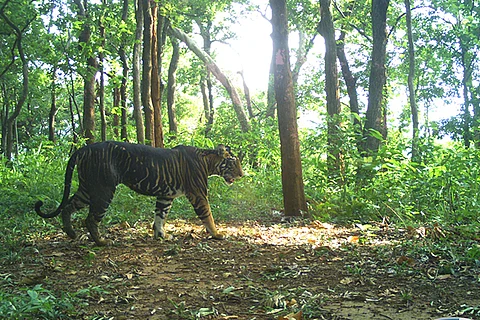

Simlipal Tiger Reserve (STR) is taking a new approach to safeguard the long-term health of its tiger population. In a first for India, the Odisha forest department plans to introduce two new female tigers to the reserve to combat inbreeding in the reserve’s unique tiger population by increasing genetic diversity.
The reserve’s residents include rare melanistic wild cats, which are pseudo-melanistic with thick and dark merged stripes, leading to their name ‘black tigers’.
STR’s tiger population has grown over time, but isolation and a lack of gene flow have resulted in inbreeding. The tiger population is homozygous due to inbreeding, which means that the tigers here have two copies of bad genetic variants inherited from both parents.
According to studies on other species, if this is not addressed, populations may suffer from inbreeding depression, meaning lower average fitness, ultimately leading to reduced population size and possibly extinction. Sariska tiger populations in India have previously collapsed as a result of adverse human impacts.
Inbreeding depression occurs following inbreeding, or mating between close relatives. As these relatives have common ancestors in the past, they share both positive and negative genetic variation. Bad genetic variation could result in the appearance of abnormalities or other traits that decrease survival or reproduction, eventually affecting population growth.
According to the All India Tiger Estimation, STR recorded five tigers in 2014, out of which only one was male, explained Prakash Chand Gogineni, field director at Baripada circle in Odisha.
“The male tiger was pseudomelanistic and as the only tiger mated with other female wildcats, the traits got transferred,” he told Down To Earth.
Eventually the population increased and as per 2024 figures, it stands at 24 adult tigers out of which 10 are male, the field director said. Today, 60 per cent of the tigers are melanistic.
According to a study- High frequency of an otherwise rare phenotype in a small and isolated tiger population, published by journal PNAS in 2020, researchers found that the tiger population had a coding alteration in gene called Transmembrane Amino-peptidase Q (Taqpep). They identified the mutation responsible for the pseudomelanistic appearance and suggested a higher occurrence of this mutation in STR because of isolation and fewer numbers.
Gogineni said the melanism is natural and has no impact on the health of the population. “It is not a negative indicator of health. However, homozygosity is not a good phenomenon for long-term conservation and hence bringing more individuals to diversify the gene pool is required,” he stated.
“Studies recommend genetic rescue of such an isolated population, which means increasing the genetic variation by gene flow — in this case, by bringing more individuals to diversify the gene pool — is required,” he added.
The field officer said the state forest department has received an in-principle approval to bring in two tigers for which a detailed project report is being prepared. “The proposal is in its final leg and will be submitted shortly to the central government and shared with Madhya Pradesh and Maharashtra state governments, after which they may agree to donate the tigers,” he said.
However, the forest service will have to be patient once the new set of female wildcats arrives. If successful, this will be the first such genetic rescue in the country.
Goginegi said that female tigers may take about a year to establish their territory and settle in. They may breed in the following year or later. “But it will take time for the new generations with diverse gene variety,” he added.
Uma Ramakrishnan, professor at Bengaluru-based National Centre for Biological Sciences and senior co-author on pseudomelanism research in Similipal, said genetic rescue of Similipal is a welcome initiative by the Odisha forest department. “We are currently doing research to better understand ‘genetically good’ source locations to bring tigers to Similipal,” she said.
The ultimate success of this management initiative will be determined, as previously stated by the field director, by how well the immigrant tigers integrate into Similipal and are able to mate with the individuals already present. If this occurs, heterozygosity should increase while inbreeding decreases over time, she added.